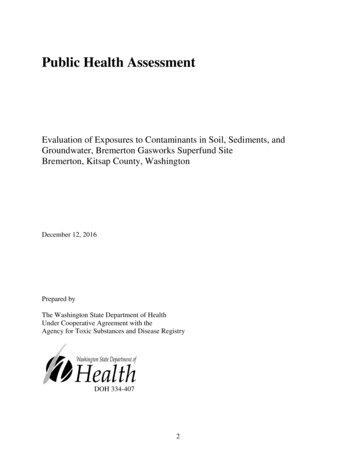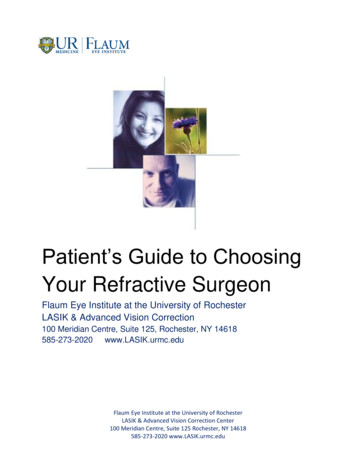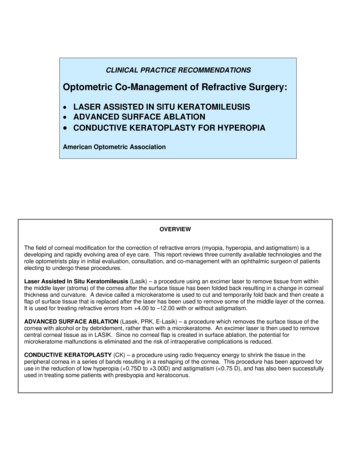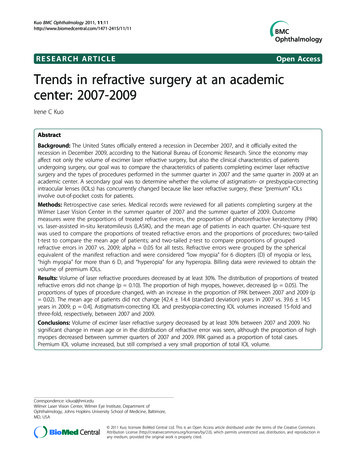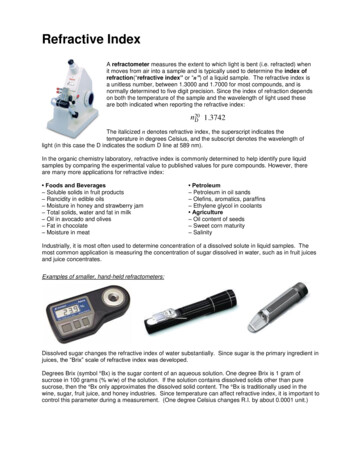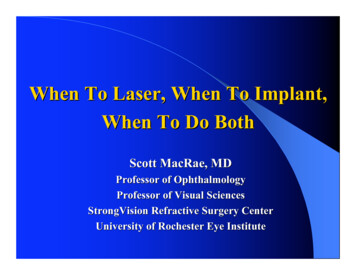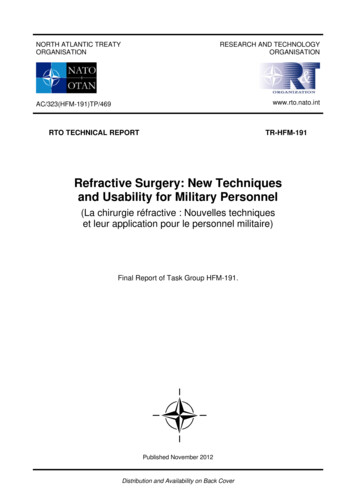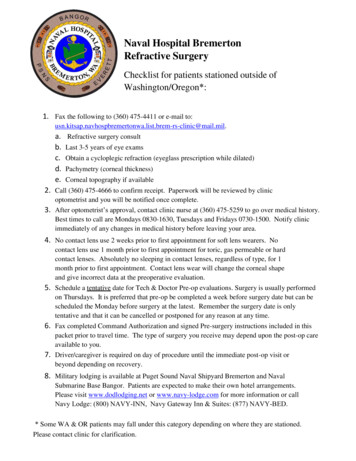
Transcription
Naval Hospital BremertonRefractive SurgeryChecklist for patients stationed outside ofWashington/Oregon*:1. Fax the following to (360) 475-4411 or e-mail ic@mail.mil.a.b.c.d.e.Refractive surgery consultLast 3-5 years of eye examsObtain a cycloplegic refraction (eyeglass prescription while dilated)Pachymetry (corneal thickness)Corneal topography if available2. Call (360) 475-4666 to confirm receipt. Paperwork will be reviewed by clinicoptometrist and you will be notified once complete.3. After optometrist’s approval, contact clinic nurse at (360) 475-5259 to go over medical history.Best times to call are Mondays 0830-1630, Tuesdays and Fridays 0730-1500. Notify clinicimmediately of any changes in medical history before leaving your area.4. No contact lens use 2 weeks prior to first appointment for soft lens wearers. Nocontact lens use 1 month prior to first appointment for toric, gas permeable or hardcontact lenses. Absolutely no sleeping in contact lenses, regardless of type, for 1month prior to first appointment. Contact lens wear will change the corneal shapeand give incorrect data at the preoperative evaluation.5. Schedule a tentative date for Tech & Doctor Pre-op evaluations. Surgery is usually performedon Thursdays. It is preferred that pre-op be completed a week before surgery date but can bescheduled the Monday before surgery at the latest. Remember the surgery date is onlytentative and that it can be cancelled or postponed for any reason at any time.6. Fax completed Command Authorization and signed Pre-surgery instructions included in thispacket prior to travel time. The type of surgery you receive may depend upon the post-op careavailable to you.7. Driver/caregiver is required on day of procedure until the immediate post-op visit orbeyond depending on recovery.8. Military lodging is available at Puget Sound Naval Shipyard Bremerton and NavalSubmarine Base Bangor. Patients are expected to make their own hotel arrangements.Please visit www.dodlodging.net or www.navy-lodge.com for more information or callNavy Lodge: (800) NAVY-INN, Navy Gateway Inn & Suites: (877) NAVY-BED.* Some WA & OR patients may fall under this category depending on where they are stationed.Please contact clinic for clarification.
Pre-Surgery InstructionsRefractive Surgery Center Naval Hospital BremertonPlease read carefully as failure to comply will result in cancellation of your surgery appointment.1.You must have a caregiver and a driver (not a Taxi) for at least 5 days which includes the day of surgery.2.Due to possible complications during recovery, patients are required to be within the immediate area of theirlocal eye doctor. Do not schedule any TAD, travel during leave, underway, PCS, etc. until after the onemonth post-op appointment.3. Command Authorization Form: Drop off to clinic, email to ail.mil or fax to (360) 475-4411 no later than 1500 Monday the week of your surgery. Please callclinic to verify receipt (360) 475-4295. You are required to bring the original on the day of surgery.4. No contact lens use 2 weeks prior to surgery for soft lens users. No contact lens use 1 month prior to surgery fortoric, gas permeable or hard contact lens users. Absolutely no sleeping in contact lenses, regardless of type for 1month prior to surgery.5. Call the clinic for any changes in your medical history including over the counter medications.6. Day Before Surgery:a. Pick-up medications by 1100 at the Naval Hospital Bremerton Pharmacy prior to checking in for yourappointment. Choose “Not in Stock Medications/Items Filled Prior to Today” at the kiosk. You willget an “O” ticket and will be called immediately as your meds are prepared the night before. You are notrequired to be in uniform. Your surgery will be cancelled if you are late.b. FEMALE patients stop by the laboratory prior to picking up medications.c. The appointment is for a group teaching of pre/post op instructions & signing of informed consent;therefore, it could last up to 1600.d. If you are not within 2 hours driving distance of the clinic, make arrangements to stay in the area thenight before (for LASIK & PRK patients) and night of surgery (for LASIK patients).e. Please be aware that your 0730 or 0800 surgery day appt time is a placeholder. You will be informed ofyour surgery check in time at the group meeting. Please make sure you and your driver’s schedule isflexible on day of surgery.7. Surgery Day:a. Eat breakfast/lunch/bring a snack. Pre-op meds needs to be taken with food.b. Your military ID will be used for verification purposes.c. We provide a free pair of sunglasses with 100% UVA and UVB protection.d. It is highly recommended that your driver waits for you here in the clinic. If not, they should bewithin a 30 minute distance from the clinic at all times.e. Please do not bring any personal belongings. Absolutely no cell phones, pagers, or electronic devices.f. Do not wear: earrings, facial piercings, necklaces, make up (especially around the eyes), facial lotions orcream, perfume, cologne or aftershave.I have read & understood the above instructions. Failure to comply will automatically cancel my surgery appt:Patient Signature/Date:I have received a copy of the above instructions:Patient Signature/Date:Pre-op info LASIK/PRKSeptember 22, 2016/sduClinic Staff Initial:
Pre Surgical Information SheetWhat to expectYou will have a minimum of three different appointments at our clinic before your day of surgery ifyou are found to be a good candidate. Today you will be seen by a technician to have manydiagnostic tests and measurements done to measure stability as well as making sure your eye anatomyfits the criteria for corneal refractive surgery. In some cases, unfortunately you may not make it pastthis first step due to thin corneas, abnormal corneas, a prescription that is unstable or other unforeseencircumstances.We want to do as many surgeries as possible, but there are risks with any type of surgery and thereare those patients where the risks are too high and against FDA regulations to proceed . In some casesyou may have to come back at a later date to have multiple tests repeated before you go to the nextstep of your evaluation.The next step is to have a dilated eye exam, where our doctors will check the health of the externaland internal structures of your eyes and get final prescription measurements. If you are deemed agood candidate after this exam you might be told that you can book a tentative date for surgery. Yoursurgery date is tentative as your chart is heavily reviewed by our surgeons, optometrist, nurse andadministrative staff to make sure that you are in fact a good candidate for surgery at that time.This procedure is elective and can be canceled at any time if we feel that the risk is too great to whereyou might not have an optimal outcome. If deemed a good candidate, along with a tentative surgerydate, you will be given an appointment to come to our clinic the day before your surgery. At thisappointment you will spend up to four hours with our clinic nurse and your surgeon for an informedconsent. You will be given further education and time to ask any unanswered questions not covered inthis education sheet and the booklet provided.Corneal Refractive SurgeryThe clear front surface of the eye is called the cornea. The cornea is comprised of different layers that dodifferent jobs. In corneal refractive surgery, it is important to get to the toughest and strongest part of thecornea called the stroma. The stroma can be permanently reshaped by a laser to try to reduce yourdependency on glasses. The stroma is covered by a top layer of skin called the epithelium. The epitheliumheals quickly and cannot be permanently reshaped. It needs to be removed or moved out of the way to getto the stroma so that the stroma can be sculpted according to your prescription.Both PRK and LASIK are refractive surgery techniques used to remove (PRK) or move (LASIK) the topsurface skin cells of the cornea, so that an ultraviolet (eximer) laser can be applied to reshape the stroma.PRK VS. LASIKPRK (Photorefractive Keratectomy)In PRK, the surgeon creates a corneal abrasion removing the top layer of cells from the cornea (called theepithelium) over the treatment area. This is done mechanically, with a soft rotating surgical brush, aftertopical numbing drops are applied. The second step of PRK is identical to LASIK: an excimer laser isused to reshape the underlying corneal tissue.After the laser ablation, a soft contact lens is placed over the eye as a bandage while the cornealepithelium grows back in place, which usually takes about 3 to 5 days. During this period, you willusually experience mild to marked discomfort with blurry vision. Because of the greater amount ofhealing that needs to take place after PRK, it can take several weeks before vision is clear and stable afterthe procedure.IntraLase LASIK (Laser Assisted In Situ Keratomileusis)The IntraLase LASIK method creates a corneal flap beneath the epithelium by applying tiny, rapid pulsesof laser light. Each pulse of light passes through the top layers of your cornea and forms a microscopicPre-op info LASIK/PRKNaval Hospital Bremerton
bubble at a specific depth and position within your eye that is determined by the doctor. As the IntraLaselaser moves back and forth across your eye, a uniform layer of bubbles forms just below the cornealsurface. Your doctor creates your corneal flap by gently separating the tissue where these bubbles haveformed. The corneal flap is then folded back so the doctor can perform the eximer laser treatment, andfolded precisely back in place once the eximer treatment has ended.What to expect day of surgery:1. Your paperwork will be reviewed while you are waiting, and any corrections or additions thatare needed will be made.2. Your identification will be confirmed at several stages along the process and we will ask if youhave any allergies to any medications, what type of procedure you are scheduled to undergoand which eye(s) will be treated.3. Our team will prepare you with several eye drops and sterile soap wash prior to entering thelaser suite. If the surgeon determines you have significant astigmatism, you may also have“marking” done on the surface of your eye.4. You will be brought into the laser suite, where you will have a seat on a “dentist-like” chair andhave the non-operative eye patched (this is for safety reasons).5. The surgeon and surgical team will all be wearing a mask and hair cover.6. For your comfort and to reduce any unnecessary head movement, you will have a special pillowplaced under your head.(LASIK only)A suction ring will be placed on the eye. Once it is centered, the surgeon will call for suction tobe applied. The suction holds the eye still while a special laser creates a flap on the surface ofthe cornea. When the suction is on, it will be difficult for you to see; things may turn gray ordark. This is a temporary effect from the suction and is normal. Your vision will returnwhen the suction is released. The suction device may be a bit uncomfortable, but will onlylast a few minutes.After the flap is created, suction will be turned off and the ring removed.An eyelid spreader will be placed into the operative eye to keep the eyelid open.This flap of tissue (Lasik flap) will be gently folded back so that your surgeon can apply theexcimer laser.(PRK only)An eyelid spreader will be placed into the operative eye to keep the eyelid open.A brush will be used to remove the top layers of skin from the surface of your cornea. It willnot be painful because you will have topical numbing medication applied. Once the tissue isremoved, your surgeon will apply the excimer laser.(PRK and LASIK)7. You will be asked to focus on a flashing red/orange light and the procedure will begin. Theflashing red light may get a little blurry during the procedure, which only lasts a few seconds toa few minutes depending on your prescription. The procedure is painless. The laser is not a“hot laser” it is ultraviolet and will not burn you.8. You will hear a popping noise next to your right ear. This is just the sound of the laser at work.You may also smell a faint odor during your procedure. This is the tissue being removed fromyour cornea. A couple of eye drops will be instilled into your eye following your procedure. Forsome patients, a bandage contact lens will be applied for temporary use only. Our staff, at yourfollow up visit, will remove this lens. Please note that your vision will be blurry immediatelyafter the procedure, but will improve with time.9. All patients will have a postoperative exam performed prior to being released. As soon as youget home you should begin taking your medication as directed and take a nap for at least 2hours to allow the healing process to begin.Pre-op info LASIK/PRKNaval Hospital Bremerton
NAVY REFRACTIVE SURGERY CONSULT FORMIncomplete Consult Forms will not be accepted1. Patient Input (Please PRINT clearly):LastNameLastNameFirstName Active DutyGrade:Rank:MISignature (date): Retired Dependent USN USCG USAF USMC OtherClinical AreaCode & Tel:UCVAOD:20/Birth Date:(DDMMYY)Age:Sex:3. Ophthalmologist/Optometrist: M FSphereSSN or DoD ID #:CylinderOU:20/AxisVA(20/x)ManOD:Job Title (No Designators):OS:Brief Job Description of Operational Duties:In your professional opinion, is this patient agood candidate for refractive surgery? Yes No Less than 0.5D change in sphere or cylinder in last 12 months Realistic expectations about obileTel:Next Billet:Check if any of the following apply: Age 21 years Hx of HSK, HZK Contacts – RGP’s Pregnancy Contacts Ext Wear Thyroid Disease Keratitis Dz affecting healing: DM, KeratoconusAtopy, CV, AI, ImmuneUnit State(2 letters):Unit Country(if not US):4. Fax Page 1 only to (360) 475-4411 orScan and email ic@mail.milProjected Rotation Date(DDMMYY):End of Active Service(DDMMYY):5. Expect a confirmation phone call within 2 weeks (NOTan email). If not contacted by then, you may call 360-4755105 option #2.2. Unit CO’s Input:Patient’s Priority Level:OS:20/1 2 3 Patients should update their contact information annuallyor when information changes.4 Refractive Surgery CenterNaval Hospital BremertonOne Boone Rd Code 044Bremerton, WA 98312-1898CO’s LastName (Print):CO’sSignature:Tel: (360) 475-5105 #2Fax: (360) 475-4411DSN: 494-XXXXPatient’s Work e-mail@Patient’s Home e-mail@
NAVY REFRACTIVE SURGERY CENTERSNational Naval Medical CenterBethesda, MDPhone: (301) 295-1200Fax:(301) 295-4751DSN: 295-xxxxNaval Hospital Camp LeJeuneJacksonville, NCPhone: (910) 450-3353Fax:(910) 450-3355DSN: 750-xxxxNaval Medical Center PortsmouthPortsmouth, VAPhone: (757) 953-7575Fax:(757) 953-6136DSN: 377-xxxxNaval Hospital BremertonBremerton, WAPhone: (360) 475-5105Fax:(360) 475-4411DSN: 494-xxxxNaval Hospital JacksonvilleJacksonville, FLPhone: (904) 542-7680Fax:(904) 542-7687DSN: 942-xxxxNaval Medical Center San DiegoSan Diego, CAPhone: (619) 524-0555Fax:(619) 524-1731DSN: 524-xxxxGUIDANCE TO UNIT COMMANDERSCorneal refractive surgical procedures are designed to reduce or eliminate the need for glasses or contact lenses in people who arenearsighted, farsighted or have astigmatism. In the Navy and Marine Corps, there are service members whose duties regularlyrequire them to perform their mission in operational environments where the use of glasses or contacts may adversely affect theirmission performance. Photorefractive Keratectomy (PRK) has been shown to significantly enhance the mission capabilities of theseindividuals, and is currently the procedure of choice for personnel in warfare communities. Research on other forms of refractivesurgery, such as LASIK, has demonstrated similar benefits, and may be suitable for personnel in certain warfare communities.NAVADMIN message 341/99 (R212221Z DEC 99), Photorefractive Keratectomy Surgery Program for Active Duty ServiceMembers, announced the implementation of the Navy and Marine Corps corneal refractive surgery program. A prioritization policyhas been designed to ensure that those active duty members whose operational effectiveness would be most enhanced by surgery arefirst in line at all times. Responsible line commanders are directed to determine the priority level merited by individual servicemembers, based on operational need, probability of enhancing mission performance, and issues of personal safety in the performanceof military duties. Appropriate determination by the line commanders is critical to the ability to provide this service to those forwhom it is truly intended to benefit, as the demand for services will likely exceed the capacity to provide them. Note that theguidelines provided below do not address rank or rate, as these are not always the most appropriate means for determining the trueindication for surgery. Service members that do not merit high priority, or do not wish to wait for the availability to have surgery ata Navy refractive surgery center, may request permission from their line commanders to have surgery performed at their ownexpense in the civilian health care sector.PRIORITY 1 (Highest Priority): This category is restricted to only those personnel whose military duties, without question,require them to frequently and regularly work in extreme physical environments that preclude the safe use of spectacles or contactlenses, or where their use has a high probability of compromising mission performance. (SPECWAR, EOD, Diver, SBU, ForceRecon, NFO/Aircrew)PRIORITY 2: This category identifies personnel whose military duties require them to frequently work in adverse physicalenvironments, where personal safety and mission performance make the use of spectacles or contact lenses impractical, but notnecessarily incompatible. (Carrier Flight Deck Ops, Ship Ops, Infantry)PRIORITY 3: This category identifies personnel whose military duties do not typically expose them to extreme physicalenvironments, but there is a reasonable expectation that the member may periodically meet the criteria for priority 2.(Office, occasionally in the field)PRIORITY 4: This category identifies personnel whose military duties rarely expose them to extreme physical environments andwhere there is no reasonable expectation of being assigned to work environments that would make spectacle or contact lens usedifficult. (Office, hospital)
Refractive Surgery Center – Naval Hospital BremertonCommand Authorization for Corrective Eye SurgeryA member of your command, (Rank, Name, SSN)has the opportunity to have corrective eye surgery at the Naval Hospital Bremerton.Type of surgery:Scheduled surgery date is:Con leave after surgery: 4 days1.Before the service member can be treated, written authorization from the member’s Commanding Officer is required.Member must provide this form (completed and signed) prior to surgery day. Surgery will be cancelled without thisform. Fax # (360) 475-4411. E-mail: mail.mil.2.The primary requirement for surgery is a commitment of the service member’s time for preoperative exam, surgery,convalescent leave, and follow-up examinations. Required / recommended exam intervals include:a) Preoperative examsb) Informed consent meetingc) Surgery and convalescent leaved) One-week postoperativee) One-month postoperativef) Three-month postoperativeg) Nine-month postoperativeApproximate total time away from duty:3.allow ½ dayallow ½ day1 to 5 days after surgeryallow ½ dayallow ½ dayallow ½ dayallow ½ day2 to 4 full days 6 half daysIf the service member desires or plans to receive follow up care from a provider other than the Refractive SurgeryCenter (possible in some cases), it requires written approval from the alternate eye care provider (below):I understand that the service member listed above is scheduled to have laser eye surgery on the date listed above.I accept responsibility for providing follow up care for this patient in accordance with standards of care.Eye care provider printed name/Phone Number4.Eye care provider signatureMember / CO Commitment checklist (initial by each statement):MBRCOMember and CO have read and understand the information on this formMember is not planning to separate or retire from the service after surgery: 6 months for AirForce, 18 months for Army and 12 months for other branches of the military.Member and CO understand there is little flexibility in exam dates / timesMember and CO understand that all appointments shall be kept as scheduledMember and CO understand member will have convalescent leave after surgery as listed aboveMember and CO understand that there are risks associated with surgery, and although the risksare very low, complications could result in loss of vision and member may no longer be fit for dutyMember and CO understand that after convalescent leave the member may have an additionalperiod of limited duty depending upon speed of recovery, nature of work, the work environmentand until all medication is completed (approximately 1-month for LASIK, and 2 months forPRK).5.At NHB Refractive Surgery Center, we will not do surgery on those service members who knowingly haveorders to deploy OCONUS minimum 1 month from date of surgery for LASIK and minimum 3 months from dateof surgery for PRK.6.Signature of member and Commanding Officer (or “by direction” authority) indicates authorization for surgeryand a commitment to comply fully with follow up requirements.Service MemberCommanding OfficerPrinted NameRank/Name/Phone#Signature/dateSignature/dateNH BREM 6220/3 (Rev. 12/11)
Naval Hospital BremertonOphthalmology & Refractive Surgery Clinic(360) 475-4295CDR David D. Hessert, M.D.OphthalmologistDepartment HeadDear Commanding Officer:We appreciate the opportunity to provide vision enhancing corneal refractive surgery to activeduty members of your unit. We believe this will make your military members more effectivewarfighters, with less reliance on glasses and contact lenses. We strive to make our processstreamlined and simple for patients coming from out of state and overseas.Unfortunately, Naval Hospital Bremerton cannot provide travel funding, local transportation orlodging. We encourage commands to provide no cost Temporary Additional Duty orders forpatients who are scheduled for refractive surgery with us. Refractive surgery typically requiresa two week commitment, and we perform surgery every Thursday. For patients unable to getTAD orders, please consider the Thursday of surgery through Monday to be five days ofconvalescent leave.We recommend the following schedule for patients coming from out of day:Saturday & Sunday:Monday:Wednesday:Thursday:Arrive SeattlePre-operative evaluationRepeat Pre-Op evaluation as necessaryGroup meeting / Informed consent / Meet with surgeonSurgery - either LASIK or PRK1 day Post-operative exam for LASIKConvalescent leave4 day Post-operative exam for PRKFinal Post-operative examLeave SeattleAgain, thank you for entrusting us with the care of your military members. Please clinic@mail.mil or call (360) 475-5105 if you have anyquestions. Thank you very much for your consideration.Very respectfully,David D. Hessert, M.D.CDR, MC, USN
Naval Hospital Bremerton . Refractive Surgery . Checklist for patients stationed outside of Washington/Oregon*: 1. Fax the following to (360) 475-4411 or e-mail to: mail.mil. a. Refractive surgery consult. b. Last 3-5 years of eye exams. c. Obtain a cycloplegic refraction (eyeglass prescription .
